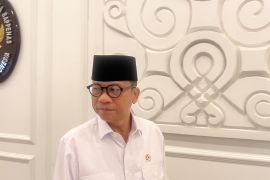According to the central bank, the amount of foreign funds flowing into Indonesia until January 9 stood at US$700 million, or about Rp9 trillion.
Since early this month, it has served as one of the contributors to stabilizing the rupiah.
"The supply and demand of foreign exchange at home are also showing a positive trend," Deputy Governor of BI Perry Warjiyo stated at the BI headquarters in Jakarta on Friday.
He noted that the supply of foreign funds was significantly influenced by the domestic economic conditions, including good economic performance of the private sector.
The performance of the private sector is improving, as the prices of almost all commodities are also showing signs of improvement.
Based on the Jakarta Interbank Spot Dollar Rate, the exchange rate of the Indonesian currency against the greenback on January 3, 2017, stood at Rp13,485 per US dollar. On Friday, the rate was recorded at Rp13,308 per US dollar.
"Besides commodity exports, the exports of manufactured products, such as motor vehicles and textiles, will also increase. If the exports perform better, it indicates that economic activities are good," he explained.
Warjiyo is convinced that the inflow of foreign funds will continue in future. Besides export performance, he pointed out that the fundamental economic indicators are also showing a positive movement.
Until early January, indicators, such as the current account transactions, exchange rate stability, and economic growth, were able to attract foreign capital.
The amount of foreign exchange reserves at the end of December 2016 was recorded at $116.4 billion, up by $4.9 billion as compared to that recorded in the previous month.
The current account deficit in 2016 was estimated to shrink to 1.8 percent of the gross domestic product (GDP) from 2.06 percent in 2015.
In view of the external pressures, particularly the US Feds plan to hike its interest rate twice this year, market players have taken anticipatory steps to prevent turmoil in the global financial market.
"The market did not respond drastically to the Feds plan, and this actually indicates that the market has anticipated it," Warjiyo pointed out.
He said that the decline in current account deficit was chiefly the result of the steady trade surplus.
According to the Central Statistics Agency, the country had recorded a trade surplus of $840 million in November 2016, although it fell from $1.21 billion a month earlier.
"Hence, we forecast the current account deficit in the fourth quarter of 2016 to reach 1.9 percent of the GDP," Warjiyo remarked at the BI Head Office.
Current account is an indicator of the exports of goods and services from a country to other nations and vice versa. Current account is divided into current accounts of goods and services.
When current account is in deficit, it means that imports are larger than exports. If the current account deficit steadily falls, exports and imports are improving.
On the other hand, the declining current account deficit will improve the balance of payment (NPI), which comprises current account, capital and financial account, and foreign exchange reserves.
"Indonesias foreign exchange reserves at the end of December 2016 rose to $116 billion, suggesting that the NPI will be positive (surplus), coupled with large foreign capital inflows," Warjiyo added.
(A014/INE/B003)
EDITED BY INE.
Editor: Suryanto
Copyright © ANTARA 2017












